Welcome to my detailed comparison between the full-frame Sony A7CII and its predecessor the Sony A7C.
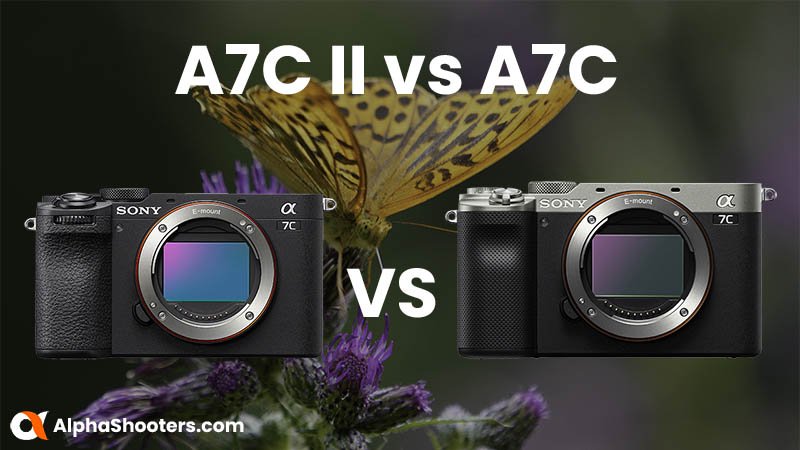
In this article I’ll be taking a look at the key differences between the Alpha 7CII and 7C compact mirrorless cameras as well as what they share in common.
I’ve also included a complete specification comparison as well as links to helpful guides and resources for each camera.
Table of Contents[Hide][Show]
Key Feature Differences+−
- Sensor & Processor
- In-Body Stabilization (IBIS)
- Still Image Recording Formats
- Movies
- Creative Look
- Autofocus
- Phase & Contrast Detection Points
- Phase Detect Autofocus Aperture Limit
- Buffer
- Full Time DMF
- Focus Bracketing
- Electronic Viewfinder and LCD Display
- Menu and Touch Control
- Camera Body & Controls
- Connectivity
- Live Streaming / Webcam
- Load / Save Settings (CAMSET)
- Firmware Updates
- Shutter When Power Off
- APS-C / Super 35 Mode
- Sony GP-X2 Grip Extension
- USB Charging
- Price Comparison
- What’s in the Box
- Conclusion
- Reviews
- Sony A7C II Guides & Resources
- Sony A7C Guides & Resources
Key Feature Differences
First let’s take a look at the key differences between the Sony A7C II and the A7C.
Sensor & Processor
The A7C features a 24.2 megapixel full-frame 35mm (35.6 x 23.8mm) back-illuminated Exmor R CMOS sensor that provides high-speed readout, high sensitivity, low noise, and highly accurate color reproduction.
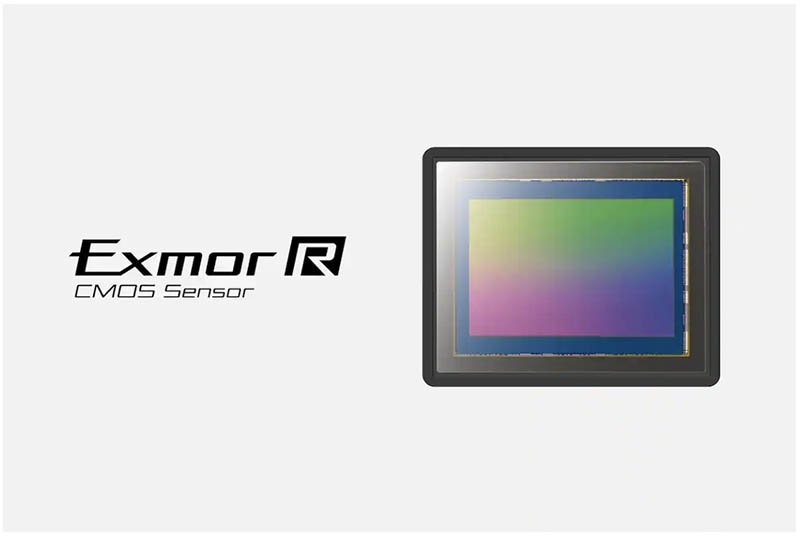
The A7C II gains some additional megapixels with a 33.0 megapixel full-frame 35mm (35.9 x 23.9 mm) back-illuminated Exmor R CMOS sensor. This is the same sensor that can be found in the Sony A7 IV.
When it comes to the processing engines the A7C features the now older BIONZ X processing engine.
The A7C II on the other hand features the latest BIONZ XR processor that boosts speed by up to 8x compared with the BIONZ X engine.
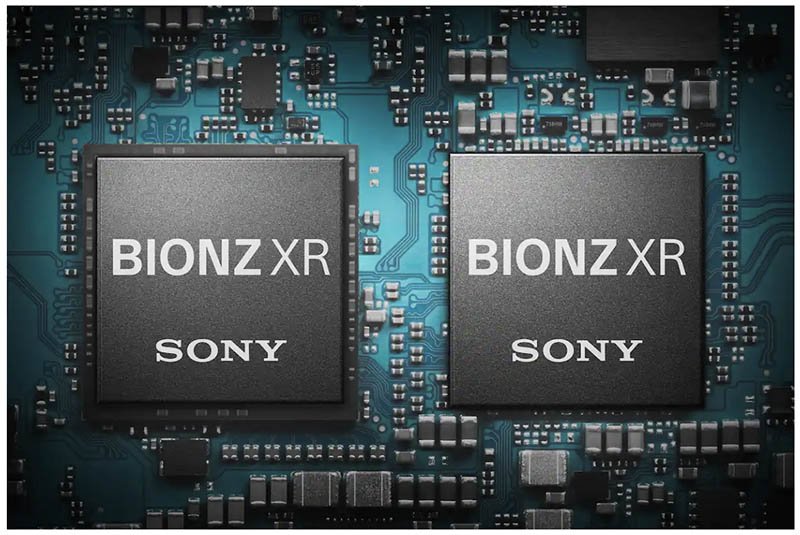
In-Body Stabilization (IBIS)
Both cameras feature Sony’s 5-axis in-body optical image stabilization (IBIS) mechanism that detects and compensates for camera shake along five different axes, including angular (pitch and yaw), horizontal, vertical and rotational, for stabilization equivalent to a 5-step faster shutter speed setting.
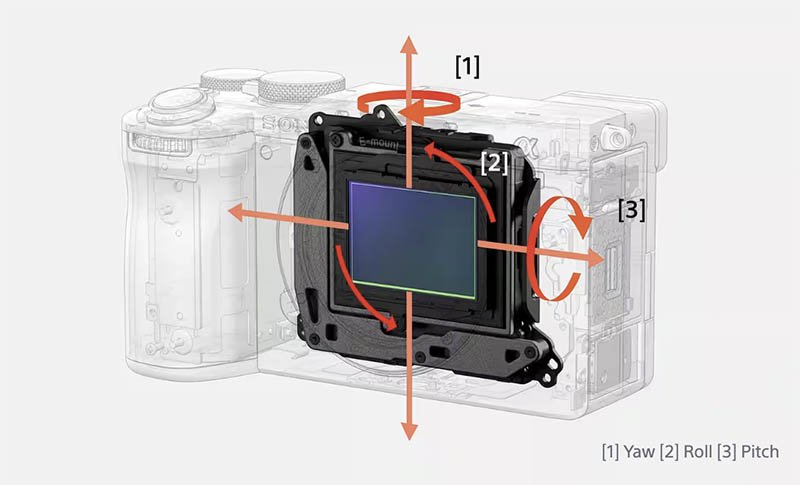
With IBIS enabled on the A7C you can benefit from 5 stops of compensation. On the A7C II this has improved to 7 stops of compensation.
Still Image Recording Formats
The A7C offers compressed and uncompressed RAW 14-bit files along with JPEGs. Although this is limited to 12 bits during compressed RAW continuous shooting, BULB exposure, or when Long Exposure Noise Reduction is activated.
The A7C II also offers compressed and uncompressed RAW 14-bit files along with JPEGs but it also gains 10-bit HEIF and RAW lossless compression options for maximum processing flexibility.
There are three lossless-compression image sizes (S/M/L) as well as a Light image quality selection that generates less data for JPEG and HEIF images.

Movies
When it comes to movie recording there’s a big difference between these two cameras.
The A7C II features the following movie capabilities that you won’t find on the A7C:
- 10-bit 4:2:2 internal recording
- 4K 30p without sensor crop
- 4K 50/60p (in Super35 mode with a 1.5x crop)
- All-Intra compression up to 600Mbps
- S-Cinetone
A HDMI micro connector (Type-D) is present on both cameras along with 3.5mm stereo microphone and headphone jacks.
Neither camera has a record time limit, so you can shoot until your battery is flat or memory card is full.
Because the A7C II is the much newer camera it also includes many more video specific features that you won’t find on the A7C, I think these are worth taking a closer look at.
Stills / Movies / S&Q Dial
The A7C II features a dedicated dial on the camera that allows you to have 3 dedicated memories for still, movies and S&Q.
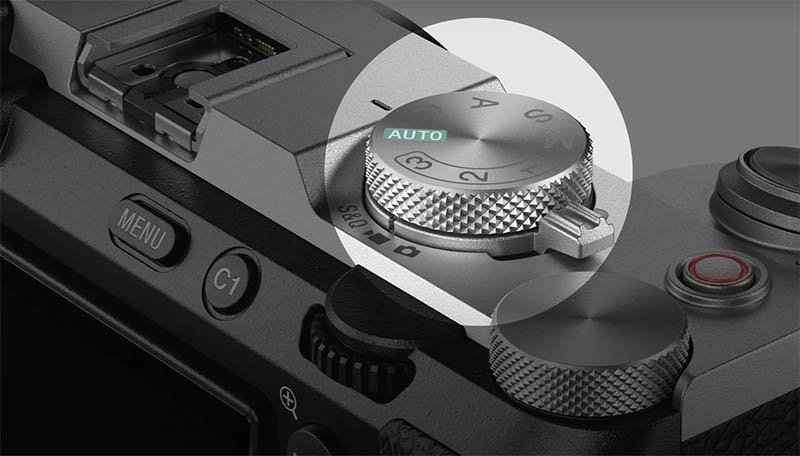
Focus Map
Focus Map lets you easily visualize depth of field when you’re shooting video. When in use, a focus (depth map) is overlaid on a display of the live view in real time, so that you can easily see which areas are in or out of focus.
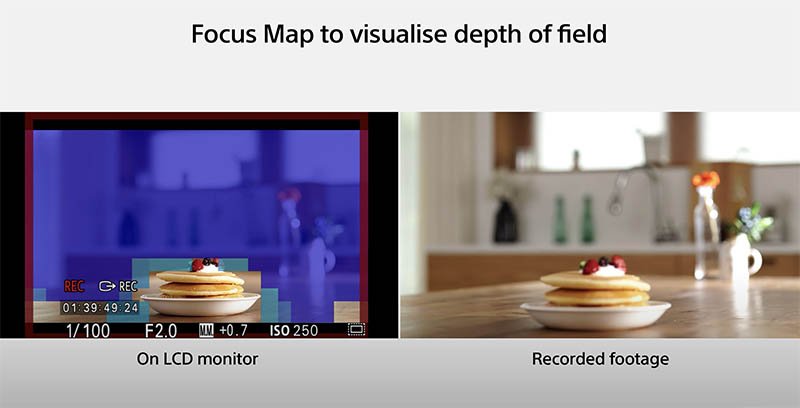
AF Assist
With this feature, manual focus can be activated while rotating the focus ring even when shooting in autofocus. Unlike touch operation, AF Assist enables videographers to shift the focus without interruption while shooting.
Real-time Tracking for Movies
AI-based Real-time Tracking provides a dramatic improvement in Real-time Tracking performance, automatically recognising, tracking, and focusing on the eyes of a specified subject. Tracking can also be initiated by touch.
Active Mode Enhanced Movie Image Stabilization
Active Mode provides additional image stabilization for handheld movie shooting. The A7C II has the ability to accurately measure camera shake which is then precisely compensated for optically. However, using this feature will result in a slight 1.13x crop.
Breathing Compensation
Breathing Compensation basically crops and resizes the video to cancel-out any change in a lens’s angle-of-view (AoV) as it focuses. In other words, there’s no distracting change of framing as you refocus.
However, this mode only works with select Sony lenses because the camera needs a profile of the breathing characteristics. You can check which lenses are compatible here.
Here’s a video demonstrating Breathing Compensation with the A7 IV.
Import User LUT files
The A7C II allows you to import a custom LUT (Look Up Table) that can be applied to the camera’s monitor while recording. This provides a preview of how your footage will look in post-processing whilst you are still shooting.
Auto Framing
The Auto Framing function automatically crops and re-frames the image while using AI to track your subject.
In-camera Time-Lapse / Interval Shooting
The in-camera time-lapse function allows you to create time-lapse videos within the camera itself. Although the A7C includes an interval timer, it does not compose the time-lapse for you in-camera, this needs to be done in post.
Creative Look
The Sony A7C II gets the newer “Creative Look” that is designed for both stills and movies.
With Creative Look you can choose the finish of an image by selecting a preferred look from 10 preinstalled looks. In addition, you can fine-tune the contrast, highlights, shadows, fade, saturation, sharpness, sharpness range, and clarity for each “Look.”
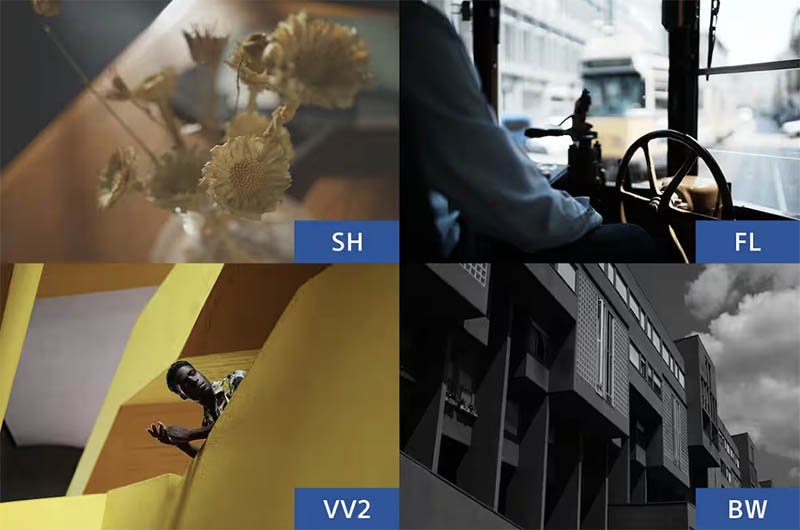
The Sony A7C has the previous “Creative Style” settings which are very similar but the adjustments for each style are limited to contrast, saturation, and sharpness making this more suitable to stills than movies.
Autofocus
The autofocus system in the A7C was excellent back in 2020 when the camera was released and it’s still great today, but it has unfortunately missed out on recent updates like real-time tracking, bird eye AF, eye tracking in movies and additional subject detection.
The A7C II is equipped with an AI processing unit that greatly increases its AF performance compared to the A7C. This includes more accurate subject recognition and a wider range of subjects.
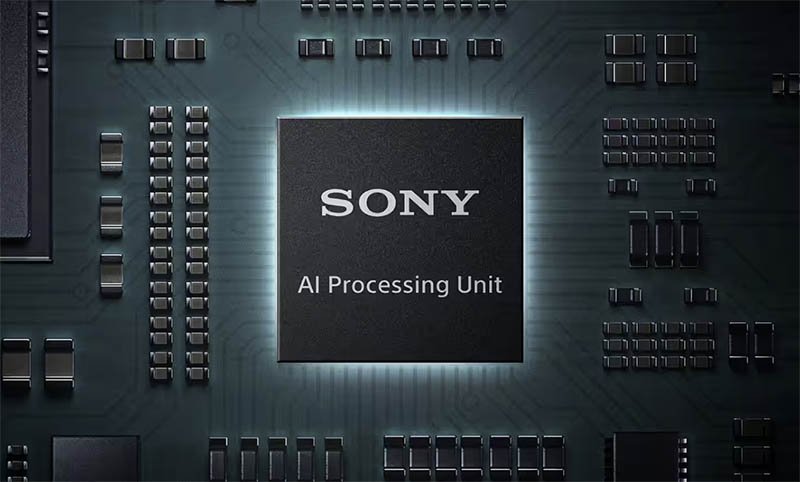
In addition to humans and animals that the A7C is capable of recognizing, the A7C II can recognize birds, insects, cars, trains and airplanes.
| Subject Detection | A7C II | A7C |
|---|---|---|
| Humans | Face, Head, Eyes, Body | Face, Eyes |
| Animals | Body, Head, Eyes | Eyes |
| Birds | Body, Head, Eyes | No |
| Insects | Yes | No |
| Cars | Yes | No |
| Trains | Yes | No |
| Airplanes | Yes | No |
Human pose estimation technology uses a skeleton-based model, enabling the A7C II to recognise not just eyes, but also body and head positions with high precision. It can even lock onto and track subjects that are facing away from the camera or with their face partially obscured.
Phase & Contrast Detection Points
The A7C features 693 phase detection points in full-frame mode covering approximately 93% of the image area. In APS-C mode with a full frame lens this drops to 299 phase detection points and with an APS-C lens this drops further to 221 points. There are also 425 contrast detection points.
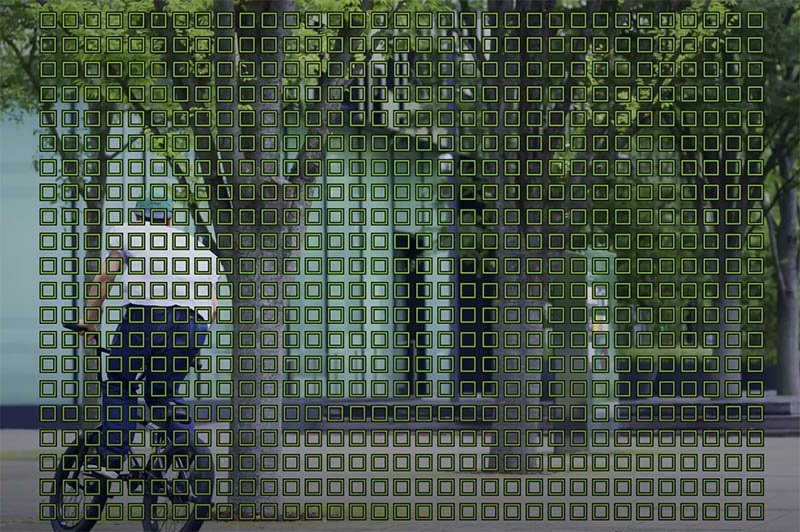
The A7C II improves on this slightly with up to 759 phase detection points, covering approximately 94% of the image area when shooting stills. For shooting movies this reduces to a maximum of 627 points.

Phase Detect Autofocus Aperture Limit
With the A7C when you are shooting with an F-value greater than F11 in [Continuous Shooting: Hi+], [Continuous Shooting: Hi] or [Continuous Shooting: Mid] mode, the slower contrast detection is used and the focus is locked to the setting in the first shot.
With the A7C II you can shoot with phase detect autofocus all the way down to F22 before contrast detection kicks in and the focus is locked to the setting in the first shot.
Buffer
If you shoot a lot of action and continuous bursts then the number of frames that you can shoot before hitting the buffer will be an important consideration.
The numbers in the table below are when shooting in Hi+ drive mode and utilizing a fast UHS-II memory card.
| JPEG Extra Fine | JPEG Fine | Uncompressed RAW | Compressed RAW | Lossless Compressed RAW | HEIF | |
|---|---|---|---|---|---|---|
| A7C II | 88 | Over 1000 | 18 | 44 | 27 | Over 1000 |
| A7C | 215 | 223 | 45 | 115 | – | – |
It seems that for some reason Sony has decided to reduce the buffer size of the A7C II instead of increase it. That is unless you are only shooting Fine JPEG files which oddly the A7C II is able to shoot over 1000 compared to 223 with the A7C.
Full Time DMF
Full Time DMF is available on the A7C II but not the A7C. This works when shooting stills with AF-C or AF-S autofocus. With DMF you can rotate the lens’s focus ring to switch to manual focus mode at any time. The A7C does not support full-time DMF unless you are using a lens with a dedicated DMF switch.
Focus Bracketing
Focus bracketing is available on the A7C II but not the A7C.
With focus bracketing you can shoot up to 299 images with sequentially shifted focus points according to intervals and a sequence specified by you. Unfortunately there is no option to automatically combine images in-camera, this needs to be done in post.
This video from Mark Galer explains more about how focus bracketing works with the a7RV, but it’s similar for the A7C II.
Electronic Viewfinder and LCD Display
Both cameras feature similar but not quite identical electronic viewfinders (EVF) and LCD displays.
Electronic Viewfinder (EVF)
Each camera features a 2.36 million dot OLED viewfinder but they are not entirely identical.
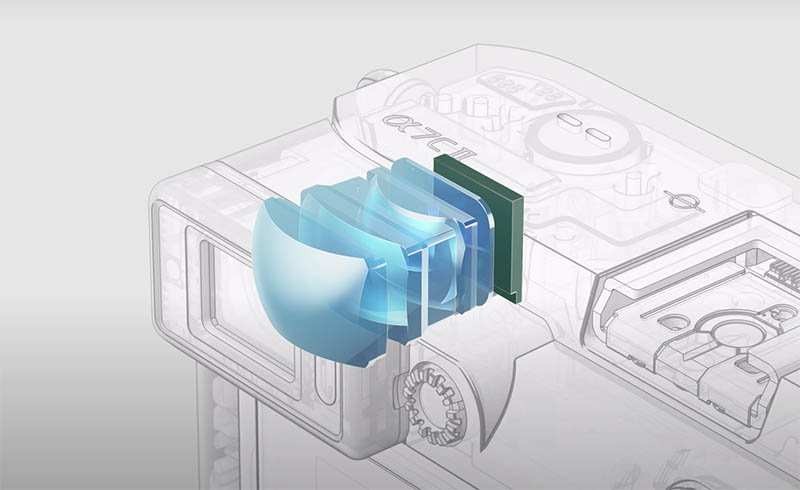
The magnification on the A7C II’s viewfinder is larger at approx 0.70x compared to 0.59x on the A7C.
Additionally, the A7C II has a longer eye-point of 22mm, while the A7C has a slightly shorter eye-point of 20mm.
| Sony A7C II | Sony A7C | |
|---|---|---|
| EVF Type | 1.0 cm (0.39 type) electronic viewfinder (XGA OLED) | 1.0 cm (0.39 type) electronic viewfinder (XGA OLED) |
| Number of Dots | 2,359,296 dots | 2,359,296 dots |
| Field Coverage | 100 % | 100 % |
| EVF Magnification | Approx. 0.70x (with 50 mm lens at infinity, -1 m-1) | Approx. 0.59x (with 50-mm lens at infinity, –1 m-1) |
| EVF Eyepoint | Approx. 22 mm from the eyepiece lens, 19.6 mm from the eyepiece frame at -1 m-1 (CIPA standard) | Approx. 20 mm from the eyepiece lens, 17.5 mm from the eyepiece frame at –1 m-1 (CIPA standard) |
| Finder Frame Rate Selection | NTSC mode: STD 60fps / HI 120fps, PAL mode: STD 50fps / HI 100fps | NTSC mode: STD 60fps / HI 120fps, PAL mode: STD 50fps / HI 100fps |
LCD Display
Both cameras feature a 2.95 inch (3.0-type) TFT display. The A7C has a resolution of 921,600 dots whereas the A7C II has a slightly higher resolution of 1 036 800 dots.
Both displays are vari-angle touch displays with an opening angle of approx. 176 deg and a rotation angle of approx. 270 deg.
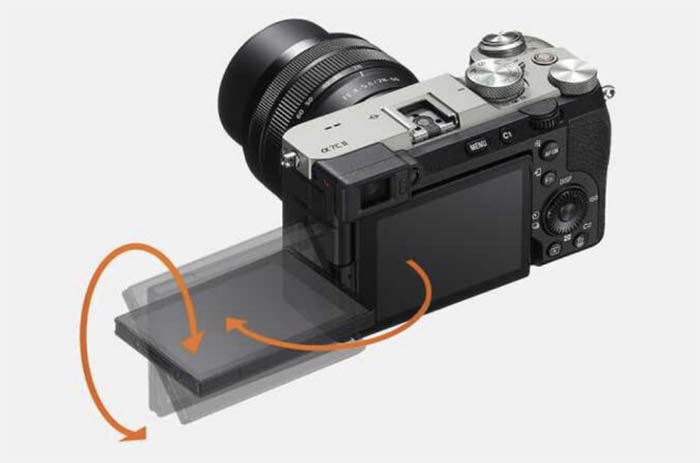
Menu and Touch Control
The A7C features an older and less intuitive menu design that is definitely showing its age.
The A7C II benefits from the latest menu design and improved touch functionality that have been incorporated into higher-end cameras like the Sony A7R V.
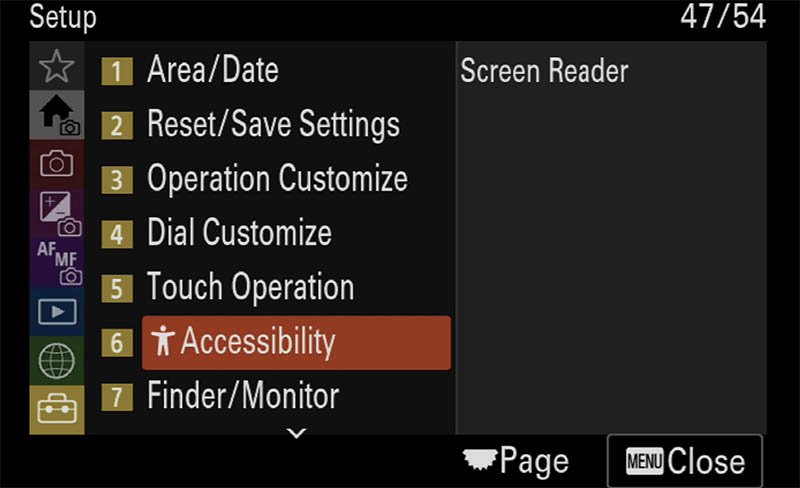
Touch functionality is also limited on the A7C to selecting the focus point and touch shutter.
With the A7C II you can now navigate the menus by touch and swiping in from the left or right edge of the shooting display to reveal touch icons that allow quick changes to the shooting mode and other settings. The function (Fn) menu can also be displayed by a simple swipe-up.
A screen reader function also reads text on the menu screens aloud, with volume and reading speed adjustable as needed.
Camera Body & Controls
The dimensions and weights of each camera are as follows:
- A7C II: W/H/D: 124.0 x 71.1 x 63.4 mm, (approx. 514 g / 1.13 lbs. with battery and memory card)
- A7C: W/H/D: 124.0 x 71.1 x 59.7 mm, (approx. 509 g / 1.12 lbs. with battery and memory card)
So apart from a few mm in depth and 5g in weight the two cameras are sized very similar.
The bodies and controls are very similar but if you look closely you’ll spot a couple of differences.
First the A7C II gains a useful front dial and also an extra lever on the top control dial to switch between stills, movies and S&Q mode. There’s also a dedicated C1 button next to the menu button on the A7C II, this is shared with the trash button on the A7C.
Both cameras are available in black or black/silver colors.
Sony A7C II
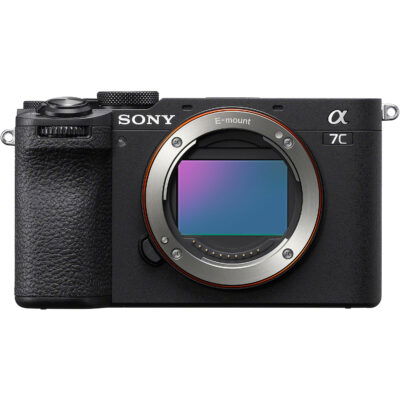
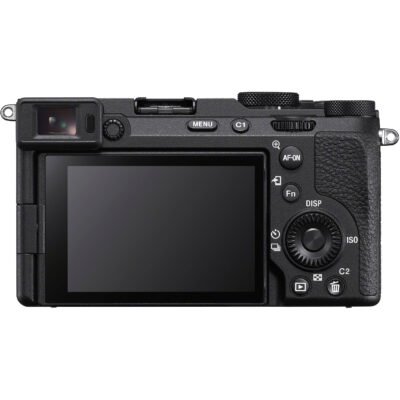

Sony A7C
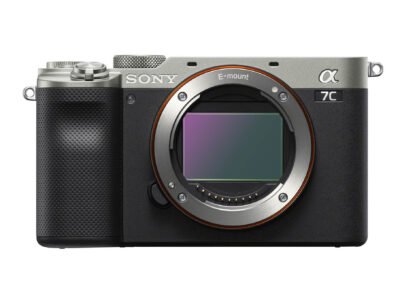
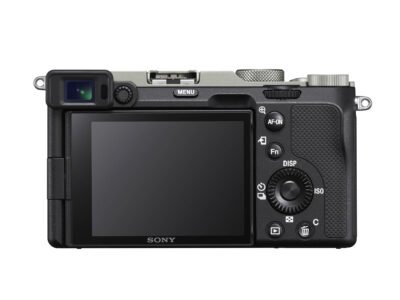
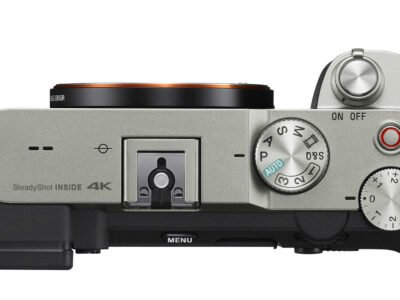
Connectivity
Both cameras feature similar connectivity options.
- 2.4 / 5 Ghz Wi-Fi
- Bluetooth standard Ver. 4.1 (A7C)
- Bluetooth standard Ver. 4.2 (A7C II)
- Micro HDMI port (type D micro jack)
- SuperSpeed USB-C 5 Gbps (USB 3.2)
- Microphone jack (3.5 mm)
- Headphone jack (3.5 mm)
- Multi Interface (MI) Shoe with digital audio
The A7C can be controlled remotely using the Imaging Edge Mobile App but functionality is limited.
The A7C II supports Sony’s newer Creators App for remote control and file management.
The Sony RMT-P1BT Bluetooth Remote (B&H Photo | Amazon) is also supported by both cameras.

Live Streaming / Webcam
The Sony A7C can be used as a webcam when using Sony’s Imaging Edge Webcam software but the resolution is limited to 1,024 × 576 pixels.
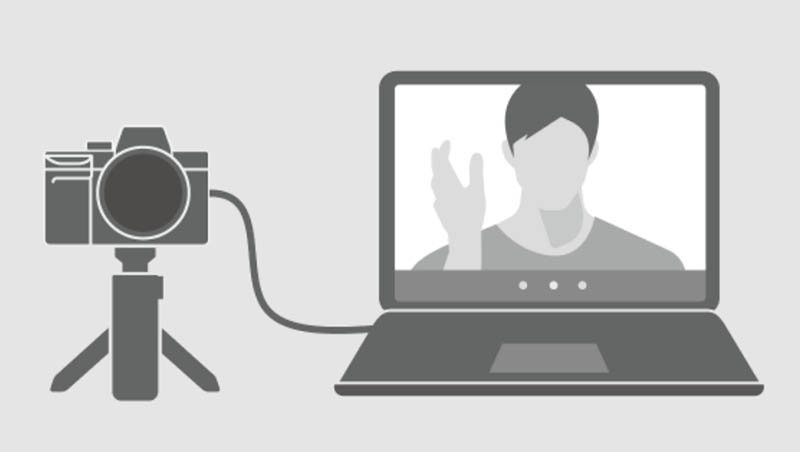
With the A7C II you just need to connect the camera to a computer or smartphone via USB, then select “Live Stream (USB Streaming)”.
The A7C II can also function as a 4K (2160p) webcam with advanced AF that makes online meetings and live streaming events even smoother.
Load / Save Settings (CAMSET)
The A7C II allows you to save/load camera settings to/from a memory card. You can save up to 10 settings per memory card. You can also load settings from another camera of the same model.
The A7C offers a more basic option that allows you to save up to 3 (M1 through M4) to a memory card, then recall the settings using the mode dial. Settings registered to a memory card using another A7C can be recalled.
Firmware Updates
Updating the Sony A7C firmware requires you to connect the camera to your computer via USB. For Mac OS users this is a nightmare as it triggers security flags and can be very difficult to install.
Thankfully the A7C II allows firmware updates via memory card which is a lot easier.
Shutter When Power Off
Only the Sony A7C II is equipped with the [Shutter When Power Off] function that closes the shutter when the camera is powered off, helping to protect the image sensor from dust and particles while changing lenses.
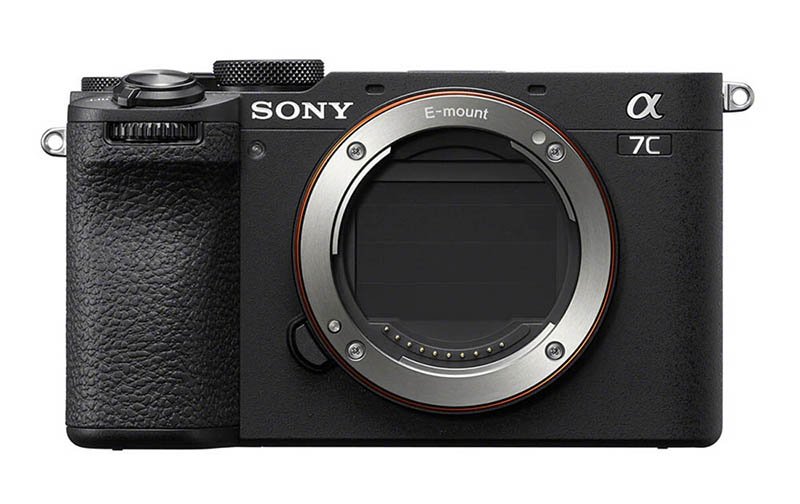
APS-C / Super 35 Mode
Both cameras feature an APS-C / Super 35 Mode. This allows you to shoot full-frame lenses with a crop factor of 1.5x or attach an APS-C lens.
If you attach an APS-C lens without using APS-C mode you will see black bars on either side of your image, this is because an APS-C lens will not completely cover the full-frame 35mm sensor.
Although both cameras feature this option when you enable it on the Sony A7C your maximum image size is limited to 10 megapixels (3936 × 2624).
The A7C II with its larger 33 megapixel sensor achieves a larger maximum APS-C image size of 14 megapixels (4608 x 3072).
Sony GP-X2 Grip Extension
If you wanted to improve the ergonomics by extending the grip of the A7C then you would need to turn to third-party options like SmallRig.

Sony has decided to create their own grip extension for the A7C II but it comes at a price. The Sony GP-X2 Grip Extension will set you back around $158.00 (Check Price at B&H Photo).
USB Charging
The A7C supports USB charging via its USB-C port. However, the A7C II also supports USB PD (Power Delivery) which enables much faster in-camera battery charging. I’m not quite sure of the exact difference in charge time so I’ll have to test this sometime.
Key Features in Common
Now let’s take a look at what these two cameras share in common.
ISO Sensitivity
There’s no difference in ISO sensitivity between these two 33MP full-frame cameras.
| A7C II | A7C | |
|---|---|---|
| Normal ISO (Stills): | ISO 100 – 51200 | ISO 100 – 51200 |
| Expanded ISO (Stills): | ISO 50 – 204800 | ISO 50 – 204800 |
| Normal ISO (Movies): | ISO 100 – 51200 | ISO 100 – 51200 |
| Expanded ISO (Movies): | ISO 100 – 102400 | ISO 100 – 102400 |
Lowlight AF Performance
Both cameras are able to achieve high AF precision down to light levels as low as EV -4.0 in AF-S mode (ISO 100 equivalent, F2.0 lens).
- A7C: EV-4 to EV20 (ISO 100 equivalent with F2.0 lens attached)
- A7C II: EV-4 to EV20 (ISO 100 equivalent with F2.0 lens attached)
Shutter
Both the A7C and A7C II feature both a Mechanical and Electronic shutter.
However, it’s important to note that despite Sony labelling it as a “mechanical shutter” neither camera has a full mechanical shutter. Instead they make use of an electronic-first curtain shutter (EFCS), in addition to the full electronic shutter.
With the mechanical shutter the maximum shutter speed is limited to 1/4000s. With the electronic shutter this increases to 1/8000s.
There are some disadvantages to using an electronic-first curtain shutter in place of a full mechanical shutter. These can include distorted images when shooting at faster shutter speeds and also less attractive bokeh but this is highly subjective. Also artificial lights can introduce banding.
I’d recommend watching this video from Mark Galer who explains in a lot more detail the issues when using EFCS.
If this is still a concern for you then you’ll probably want to look at a camera like the Sony A7 IV which has a full mechanical shutter.
Both cameras allow you to set the shutter speed to a maximum of 30 seconds when using Bulb Mode. However, the A7C II allows you to set longer shutter times but only when using the mechanical shutter.
Drive Speed
Both cameras are capable of continuous shooting at up to 10 fps with AF/AE tracking, and up to 8 fps in live-view mode that helps to keep focus on a moving subject.
However, this speed is only achievable when shooting compressed RAW, JPEG or HEIF file types, it drops to around 6 FPS when shooting uncompressed or lossless compressed RAW.

Memory Cards
Both cameras feature a single memory card slot on the side of the camera that supports UHS-I / II SD cards.
To find out which are the best memory cards to use in the A7C, please visit my Sony A7C Memory Card Guide.
Or visit my Sony A7C II Memory Card Guide to learn more about the best memory cards for the A7C II.
Battery
Both cameras utilize the Sony NP-FZ100 battery.

Price Comparison
At the time of writing this article the A7C II costs around $500 more than the A7C. However please do check the latest prices since these change often.
| Sony A7C II | Sony A7C | |
|---|---|---|
| MRSP Body-Only | $2,198.00 / £2,099.00 | $1,708.00 / £1,699.00 |
| Check Prices / Deals | B&H Photo | Amazon | B&H Photo | Amazon |
What’s in the Box
The box contents of each camera are similar except the A7C includes a USB adapter and a USB-A to USB-C cable.
Sony has excluded the USB Adaptor and Micro USB cable (B&H Photo) from the A7C II. So hopefully you already have one at home.
| Sony A7C II | Sony A7C |
|---|---|
| Sony A7C II Body | Sony A7C Body |
| Rechargeable Battery: NP-FZ100 | Rechargeable Battery: NP-FZ100 |
| Shoulder strap | AC Adaptor: AC-UUD12 |
| Body cap | Shoulder strap |
| Accessory shoe cap | Body cap |
| Accessory shoe cap | |
| USB-A to USB-C cable (USB 3.2) |
Conclusion
With around 3 years between these two cameras its hardly surprising to see so many new features such as 4k60p, 10bit internal recording, a much faster processor and AI processor for improved subject tracking make there way into the A7C II.
Here’s a quick refresh of the key advantages that the A7C II has over the A7C:
- BIONZ XR processor
- IBIS with 7 stops of compensation
- Stills / Movies / S&Q Dial
- 10-bit 4:2:2 internal recording
- 4K 30p without sensor crop
- 4K 50/60p (in Super35 mode with a 1.5x crop)
- All-Intra compression up to 600Mbps
- S-Cinetone
- Creative Look
- Active Mode enhanced movie image stabilization
- Lossless RAW & HEIF file formats
- Import User LUT files
- 759 PDAF points
- Real-time tracking of birds, insects, cars/trains, and airplanes
- Human pose estimation
- In-camera time-lapse creation
- Auto framing
- Focus breathing
- Focus bracketing
- Focus map (movies)
- AF Assist
- Full-time DMF
- Firmware updates via memory card
Ultimately, the decision between the A7C and A7C II will probably come down to your budget.
The A7C is still more than capable of capturing stunning images, it’s just that the A7C II makes this a little bit easier with it’s AI processor.
And that’s it for this comparison. Please do let me know in the comments below if you found this comparison helpful or have any questions.
Finally. Please don’t forget to take a look at our friendly Alpha Shooters Community Forum before you leave. Thank you!
Table of Contents[Hide][Show]
Key Feature Differences+−
- Sensor & Processor
- In-Body Stabilization (IBIS)
- Still Image Recording Formats
- Movies
- Creative Look
- Autofocus
- Phase & Contrast Detection Points
- Phase Detect Autofocus Aperture Limit
- Buffer
- Full Time DMF
- Focus Bracketing
- Electronic Viewfinder and LCD Display
- Menu and Touch Control
- Camera Body & Controls
- Connectivity
- Live Streaming / Webcam
- Load / Save Settings (CAMSET)
- Firmware Updates
- Shutter When Power Off
- APS-C / Super 35 Mode
- Sony GP-X2 Grip Extension
- USB Charging
- Price Comparison
- What’s in the Box
- Conclusion
- Reviews
- Sony A7C II Guides & Resources
- Sony A7C Guides & Resources
Reviews
To learn more about these two cameras I’d recommend watching these two reviews from Chris and Jordan.
Sony A7C II Guides & Resources
Sony A7C Guides & Resources
Complete Feature & Spec Comparison
To make sure nothing is missed here’s a complete comparison of the features and specifications of each camera.
Key Features
| Feature | Sony A7CII | Sony A7C |
|---|---|---|
| Announced | August 29th, 2023 | September 15th, 2020 |
| Camera Type | Mirrorless | Mirrorless |
| Sensor Size | 35mm full frame (35.9 x 23.9 mm) | Full-Frame (35.6 x 23.8 mm) |
| Sensor Type | Back-illuminated Exmor R™ CMOS image sensor | Back-illuminated Exmor R™ CMOS image sensor |
| Resolution | 33 MP | 24.2 MP |
| Sensor Pixel Size | 5.12µm | 5.93µm |
| Pixel Dimensions | 7008 x 4672 | 6000 x 4000 |
| Image Processor | BIONZ XR™ | BIONZ X |
| Low Pass Filter | Yes | Yes |
| IBIS (In-Body Image Stabilization) | Yes (7 Steps) | Yes (5 Steps) |
| Active Mode Stabilization | Yes | No |
| Base ISO Stills | ISO 100 | ISO 100 |
| Max Native ISO Stills | ISO 51200 | ISO 51200 |
| Extended ISOs Stills | ISO 204800 | ISO 50-204800 |
| High-Resolution Sensor Shift | No | No |
| Focus Bracketing | Yes | No |
| Full Time DMF | Yes | No |
| Pre-Shoot Burst Mode | No | No |
| Fastest Shutter Speed (Mechanical Shutter) | 1/4000 sec | 1/4000 sec |
| Fastest Shutter Speed (Electronic Shutter) | 1/8000 sec | 1/8000 sec |
| Longest Shutter Speed | 30 seconds + Bulb | 30 seconds + Bulb |
| Continuous Shooting (Mechanical Shutter) | 10 FPS | 10 FPS |
| Continuous Shooting (Electronic Shutter) | 10 FPS | 10 FPS |
| Notes for High FPS Shooting | The maximum speed is only possible shooting compressed RAW, JPEG or HEIF file types. Live View reduces to 8 FPS. | The speed of continuous shooting decreases when shooting in uncompressed compressed RAW. |
| Buffer Size (RAW Uncompressed) | 18 | 45 |
| Buffer Size (RAW Compressed) | 44 | 115 |
| Buffer Size (RAW Lossless Compressed) | 27 | |
| Buffer Size (JPEG Extra Fine) | 88 | 215 |
| Buffer Size (JPEG Fine) | Over 1000 | 223 |
| Buffer Size (HEIF) | – | – |
| Autofocus System | Fast Hybrid AF (phase-detection AF / contrast-detection AF) | Fast Hybrid AF (phase-detection AF / contrast-detection AF) |
| AF Subject Detection | Humans, animals, birds, insects, cars/trains, and airplanes | Humans, animals |
| Autofocus Points | 759 | 693 |
| Maximum Low-Light AF Sensitivity (Standardized to f/2, ISO 100) | -4 EV | -4 EV |
| Standard Flash Sync Speed | 1/160 s (35mm full frame), 1/200 s (APS-C) | 1/160s |
| Curtain to Protect Sensor at Shutdown | Yes | No |
| Interval Shooting | Yes | Yes |
| Soft Skin Effect (stills / movies) | Yes | No |
| Creative Look | Yes | No (Creative Styles) |
| My Image Style | Yes | No |
| Background Defocus | No | No |
| Face Memory | – | No |
Video Specific Features
| Feature | Sony A7CII | Sony A7C |
|---|---|---|
| Maximum Video Bit Depth (Internal) | 10 bits | 8 bits |
| Maximum Video Bit Depth (External) | 10 bits | 8 bits |
| Raw Video | No | No |
| 4K Maximum Frame Rate | 60p/50p | 30p |
| 1080P Maximum Frame Rate | 120p | 120p |
| Additional Video Crop Factor | 1.5x crop at 4K 60p (4K 30p has no additional crop) | 1.2x crop at 4K 30p |
| Chroma Subsampling | 4:2:2 | 4:2:1 |
| Video Recording Limit | No | No |
| S-Cinetone | Yes | No |
| Picture Profiles (stills/movies) | Yes | Yes |
| Active Stabilization | Yes | No |
| Focus Breathing Compensation | Yes | No |
| Import User LUT Files | Yes | No |
| AI Auto Framing | Yes | No |
| Focus Map | Yes | No |
| AF Assist | Yes | No |
| Time Code (TC) | Yes | Yes |
| In-Camera Time-Lapse Creation | Yes | No |
| Framing Stabilizer | – | No |
| Product Showcase Set | – | No |
| Cinematic Vlog Setting | – | No |
| Multiple Face Recognition in Intelligent Auto Mode | – | No |
Physical & Other Features
| Feature | Sony A7CII | Sony A7C |
|---|---|---|
| Card Slots | 1 | 1 |
| Slot 1 Type | SD (UHS-II / I) | SD (UHS-II / I) |
| Rear LCD Size (Diagonal) | 7.5 cm (3.0-type) type TFT | 7.5 cm (3.0-type) type TFT |
| Rear LCD Resolution | 1 036 800 dots | 921,600 dots |
| Articulating LCD | Fully Articulating | Fully Articulating |
| Touchscreen | Yes | Yes |
| Viewfinder | EVF | EVF |
| Viewfinder Magnification | 0.70x | 0.59x |
| Viewfinder Resolution | 2 359 296 dots | 2 359 296 dots |
| Viewfinder Coverage | 100% | 100% |
| Voice Memo | No | No |
| Headphone Jack | Yes (3.5 mm Stereo minijack) | Yes (3.5 mm Stereo minijack) |
| Microphone Jack | Yes (3.5 mm Stereo minijack) | Yes (3.5 mm Stereo minijack) |
| Built-in Microphone | Built-in, stereo | Built-in, stereo |
| Built-in Flash | No | No |
| GPS | No | No |
| Bluetooth | Yes (Bluetooth Standard Ver. 4.2 (2.4 GHz band)) | Yes (version 4.1) |
| WiFi | Yes (Wi-Fi Compatible, IEEE 802.11a/b/g/n/ac (2.4 GHz band/5 GHz band)) | Yes (2.4 / 5 Ghz) |
| USB Type-C | Yes (SuperSpeed USB 5 Gbps (USB 3.2) compatible) | SuperSpeed USB 5Gbps (USB 3.2) |
| Multi / Micro USB Terminal | No | No |
| HDMI Port | Yes. HDMI micro connector (Type-D) | Yes. HDMI micro connector (Type-D) |
| Multi Interface Shoe | Yes (with Digital Audio Interface) | Yes (with Digital Audio Interface) |
| Battery Type | NP-FZ100 | NP-FZ100 |
| Battery Life Stills (Viewfinder) | 530 frames (CIPA standard) | 680 frames (CIPA standard) |
| Battery Life Stills (Rear LCD) | 560 frames (CIPA standard) | 740 frames (CIPA standard) |
| Battery Life Video Actual (Viewfinder) | 100 minutes (CIPA standard) | 140 minutes (CIPA standard) |
| Battery Life Video Actual (Rear LCD) | 105 minutes (CIPA standard) | 140 minutes (CIPA standard) |
| Weather Sealed | Yes | Yes |
| Weight (Body Only) | Approx. 429 g (0.95 lbs.) | Approx. 424 g (0.93 lbs.) |
| Weight (With Battery & Card) | Approx. 514 g (1.13 lbs.) | Approx. 509 g (1.12 lbs.) |
| Dimensions (LxHxD) | Approx. 124.0 x 71.1 x 63.4 mm, Approx. 124.0 x 71.1 x 58.6 mm (from grip to monitor) / Approx. 5 x 2 7/8 x 2 1/2 inches, Approx. 5 x 2 7/8 x 2 3/8 inches (from grip to monitor) | Approx. 124.0 x 71.1 x 59.7 mm, Approx. 124.0 x 71.1 x 53.5 mm (FROM GRIP TO MONITOR) Approx. 4.88 x 2.80 x 2.35 inches, Approx. 4.88 x 2.80 x 2.11 inches (FROM GRIP TO MONITOR) |
| Operating Temperature | 0 – 40 ℃ / 32 – 104 °F | 0–40 °C/32–104 °F |
Sony A7C / A7CII / A7CR Forum & Facebook Group
If you are looking for further help and advice on the A7C or would simply like to share your photos and videos, then please head over to our friendly full-frame Forum. If you prefer Facebook then I also run the Sony A7C + A7CII + A7CR Shooters Group.




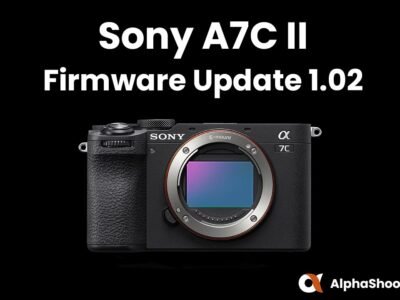

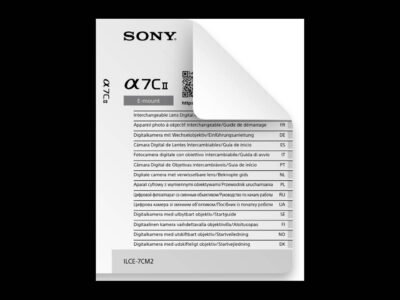

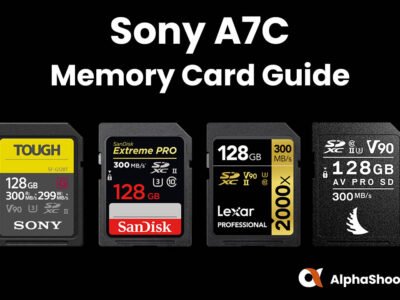




Leave a Reply